 GLASS IN THE PAST By Gordon Bock
GLASS IN THE PAST By Gordon Bock
OLD HOUSE JOURNAL August 1998
PLEASE NOTE: I inspect a lot of turn of the century homes and have always wondered why the older glass was wavy. I found this article in an old edition of the Old House Journal and my clients always aske why the old glass is wavy. If you have an older home, I highly recommend subscribing to the Old House Journal.
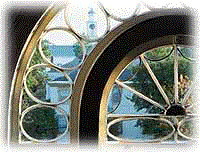
Old window panes look wavy, distorted, and handmade - even after 1900. Understand their manufacture, and you'll know why.
Ever peer through an old window and see ... the glass? The distortions in antique glass are part of the charm of old windows and a historic feature well worth retaining. Though some may tell you that ripples and dimples are a sign of age - as if glass sags like flesh after a century - the truth is less fantastic, though almost as amazing.
It's all a result of how glass was made. Once you grasp the two basic methods used to make window glass until the 1910s, you can tell a lot about the age of your windows and how to care for them.
Crown Glass
For centuries, the best quality window glass was crown glass. To make panes with this method, a glass blower gathered a clump of molten glass on the end of a hollow pipe and blew it into a bubble much like a bottle. As a helper attached a pontil rod to the other side of the bubble, the glassworker broke off the blowpipe creating a hole. Then, by heating the glass and coaxing it with a wood paddle, he quickly enlarged this hole into a rough plate.
Working in front of a furnace to keep the glass hot and fluid, the worker then spun he rod with his hands, often on a supporting bench, so that centrifugal force stretched the glass out into a thin disc - a process nearly identical to a baker spinning fresh pizza dough for a pie. When the blower severed the rod, he had a disc of thin glass, up to 4 feet in diameter.
After annealing this table in another oven to equalize stresses, the glass was carefully cut into panes according to grade and size. The central "bull's-eye" - the thickest and most malformed part where the rods touched - was usually unsalable and returned to the furnace.
In colonial America, however, whole or half tables of crown glass were regularly used uncut, often in gable windows. (Thomas Jefferson ordered several for the oculus and porthole windows at Monticello.) When thrifty Yankees divided up the tables, they put even the bull's-eyes to use in door or barn transoms where light meant more than a view.
Cylinder Glass
Though crown glass was made up to the 1850s, it could not supply the need for bigger panes created by a growing population. The glass that could was cylinder glass (also called broad glass or sheet glass), and it dominated this industry for the rest of the century.
To make cylinder glass, the glassworker blew a large tube of glass. After cracking off the blowpipe, the glassworker cut off the ends and slit the tube down one side. From here these shawls were transferred to a special oven where they could wilt and unfold into a flat sheet.
By the 1870s, glass manufacturers were adding pits dug deep in the floor of the glass factory to allow blowers to swing the glass as they blew. The resulting cylinders were up to 18 inches in diameter and a remarkable 7 feet in length.
Two decades later, some manufacturers had mechanized the steps with cranes and compressed air. These cylinders made possible by the Lubbers process - the last before the switch to drawn-sheet glass manufacturing in this century - were several feet in diameter.
Doing Old Windows
You can determine whether you have crown or cylinder glass simply by eye and feel. In crown glass, the spinning process leaves subtle curved swirls or ripples in the panes that appear when you look obliquely at the glass. In cylinder glass there are faint parallel ripples - the clash between the different inner and outer circumferences of the cylinder as the shawl is unfolded.
When cutting glass for window repairs, the point to remember is that cylinder glass has a smooth side, once the outside of the cylinder, and a rough side, the former inside. Your chances of a clean cut are better if you cut from the smooth side. Most original crown glass is rare enough that you probably don't want to cut it at all.
Whatever your windows, they may be hard to clean because decades of weathering have left minute pits in the surface. Instead of spray cleaners, use a paste product such as Glas Wax which you can buff to show off your beautiful wavy glass.
 MAKING CROWN GLASS
MAKING CROWN GLASS
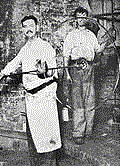
Even as late as 1900, spinning 35 pounds of crown glass at the end of a 15-pound rod took muscle.
 Rather than go to waste, bull's-eyes might be set in transoms, but never used in even the poorest window.
Rather than go to waste, bull's-eyes might be set in transoms, but never used in even the poorest window.
 MAKING CYLINDER GLASS
MAKING CYLINDER GLASS
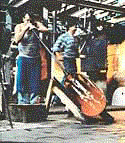
At Glashutte Lamberts in Germany, artisans still make mouth-blown cylinder glass. The process starts with a red-hot balloon of glass.
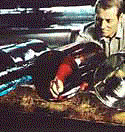
After cutting off the ends, the new cylinder is inspected for quality. Scoring the cylinder lengthwise with a glass cutter severs the cylinder into a shawl.

When placed in the furnace, the shawl unfolds with the aid of an artisan into a sheet of glass.
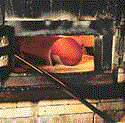
After more heating and cooling, the final sheet is ready for grading and cutting.
Thanks to Kenneth M. Wilson and S.A Bendheim Co. for technical help with this article.
Suppliers
Mouth-blown cylinder glass
- S. A. Bendheim Co Inc. 61 Willet St. Passaic, N.J. 07055 (800) 221-7379
Beveled glass products
- Beveled Glass Works Inc. 23852 Pacific Coast Hwy, Suite 351 Malibu, Calif. 90265 (800) 421-0518
Decorative overlay
- Stained Glass Overlay Inc. 1827 N. Case St. Orange, Calif. 92665 (800) 944-4746